The piece of the month of May 2014
AFTER EL GRECO IN THE MUSEUM OF NAVARRA
Mercedes Jover Hernando
Marta Arriola Rodríguez
Museum of Navarra
The Museum of Navarra celebrates the fourth centenary of the death of El Greco commemorated in 2014, with a guided pathway through three pieces exhibited in its permanent exhibition . The first sample how El Greco's contemporaries painted. The next two show his imprint on 20th century Navarre painting.
The time of El Greco in the Museum of Navarre
In 1556 the sculpture of the Plateresque façade of the Hospital de Nuestra Señora de la Misericordia, which today, almost five centuries later, gives access to the Museum, was completed. Behind this façade, forming part of its important collection of pieces, are exhibited some contemporary to its construction that are shown in the conference room of Renaissance painting.
It was still twenty years before El Greco arrived in Spain and developed that style staff that constitutes a parenthesis of independence in Spanish painting. Meanwhile, his contemporaries of the last third of the 16th century, painted "in the manner of", revealing in their paintings what they had learned in Italy from the great masters such as Michelangelo, Raphael, Titian or Tintoretto.
This is the case of the painter and sculptor Gaspar Becerra (1520-1568) who, after twenty years in Rome, returned to Spain in 1556. With his works he established the instructions of Romanism in the schools of the northern peninsular during the last third of the 16th century. His Annunciation exhibited here reminds us of the genius of the Sistine Chapel, especially in the resounding Anatomy of the archangel Gabriel, as well as in the floating forms and the iridescent color. It is evident why Becerra is considered the introducer of the forms and models of Michelangelo's mannerism in these lands.
The Annunciation is one of the themes that El Greco would represent repeatedly and that allows us to clearly see his pictorial evolution.
Among all those he painted, we look at the one of 1576, an oil on canvas of smaller format of those executed in his Toledo period, presumably done at the end of his stay in Italy, during his stay in Rome. It has a taste for Mannerist colors and reveals debts from the art of Tintoretto and the Venetian school filtered by the Michelangelesque forms, which, as in Becerra's work, can be seen in the canon of the archangel. The Italian influence can also be seen in the tiling that emphasizes the geometric perspective, so sought after and studied in the Quattrocento.
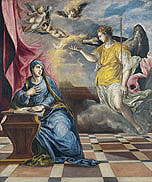
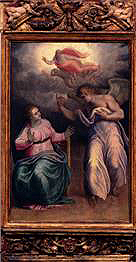
Left: The Annunciation, El Greco, c. 1576. Oil on canvas, 117 x cm. Thyssen-Bornemisza Museum, Madrid.
Right: The Annunciation, Gaspar Becerra, 16th century. Oil on panel, 156 x cm. Museum of Navarra, conference room 2.11
On the other hand, the very personal style of El Greco, which blossomed in Toledo, is evident in this other Annunciation painted in 1597. Of large dimensions, it offers a composition in a cross built by a double diagonal whose center occupies the dove of the Holy Spirit, nexus of union between the celestial world, wrapped in a Breaking of Glory, resource very habitual of the Cretan, and the terrestrial world. In this one are Mary -very stylized- and the archangel Gabriel -recently perched- of vibrant elongated Anatomy . The white light highlights the pale flesh tones of El Greco's figures, which accentuate the spiritual character of his paintings.
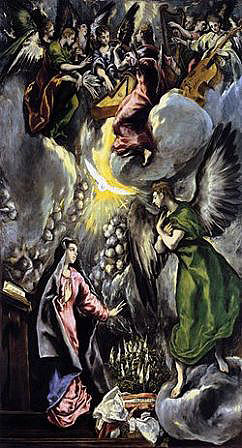
The Annunciation, El Greco, c. 1597
Oil on canvas, 315 x cm
Museo Nacional del Prado, Madrid
El Greco's imprint in the Museum of Navarre
After his death on April 7, 1614 in Toledo, El Greco was almost completely forgotten and totally misunderstood for almost three centuries, only to be rediscovered at the end of the 19th century. Since then, numerous artists and art history theorists have appreciated the work of the Cretan painter and have pointed out his influence on contemporary artists, a mark only comparable to that of Velázquez and Goya.
The Crucifixion of Christ, because of its transcendental importance in Christianity, is one of the most represented themes in the art world. The dramatic significance of the scene combines many appealing factors for any artist. First of all, the sense of ultimate sacrifice and acceptance of death as a way of salvation for man. Also, the presence of pain and suffering at Degree maximum, and in the face of it, the dignity and acceptance of destiny.
Of the various crucifixions painted by El Greco we have selected the one he painted in 1588 where the crucified appears accompanied by the Virgin, Mary Magdalene and St. John at the foot of the cross. A work of maturity, it already shows his characteristic longitudinal elongation in the figures but not another of his distinctive features of this period, the proliferation of characters. El Greco chooses perhaps to emphasize the suffering solitude of Christ in spite of his companions, who in a gesture of approaching him direct their gazes to the cross.
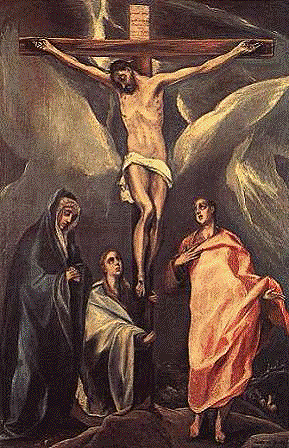
Christ on the Cross with the two Marys and St. John, El Greco, 1588
Oil on canvas, 120 x cm
National Gallery of Athens, Greece
During his years in Madrid, Julio Martín-Caro (Pamplona 1933 - Madrid 1968) frequently visited the halls of the Prado and was fascinated by the great masters for hours. In 1955 he took part in a collective exhibition at the Círculo de Bellas Artes where he met the painter Carlos Pascual de Lara, to whom he owes his admiration for El Greco. The spirituality and chromatism of the Cretan inspired him to paint the oil painting Al pie de la Cruz (At the Foot of the Cross). With this work he won a third medal and the award of the Madrid City Council in the Salón de Otoño of the same year.
Martín-Caro uses the topic of the Crucifixion as a symbol of his own suffering, which he tries to conjure up through painting. If in El Greco's canvas we appreciate the loneliness of the crucified, how much more we are not going to do it in the work of the Navarrese painter, in which the protagonist of the scene overflows the physical framework of the canvas in an attempt to escape the earthly pain that so expressively is collected in each of the faces of the portrayed characters.
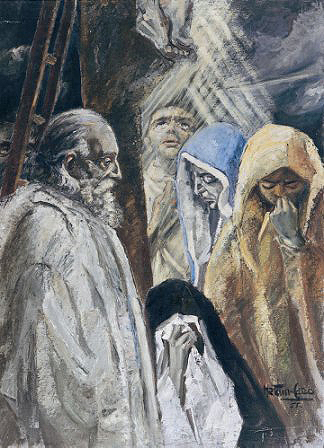
At the Foot of the Cross, Julio Martín-Caro, 1955
Oil on canvas, 110 x cm
Museum of Navarra, conference room 4.4
Picasso said: "I do not paint what I see, I paint what I think". This intellectual character of painting is also found in El Greco. His work Vista de Toledo, besides being considered one of the first isolated landscapes in the history of painting -which underlines the modernity of the artist- sample a subjective view of the city that has led to various interpretations of its meaning. El Greco not only paints the Toledo he sees and reflects in the emblematic buildings, but the one he thinks, because the change of location of some of them gives an impossible image from any real status , which warns us that the painter's intention was not so much to provide an objective fidelity of the urban reality, but to achieve a plastic synthesis as an iconic symbol of the city.
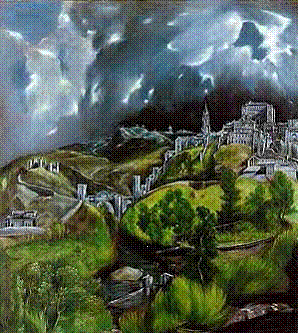
View of Toledo, El Greco, c. 1604
Oil on canvas, 121 x cm
Metropolitan Museum of Art, New York
Like El Greco's, the landscape of José María Ascunce (Beasain 1923 - Pamplona 1991) also moves away from academicist conventions. Both authors leave the path of naturalism to take that staff path that is expressionism. "The sky in a painting is the way the painter decides it should be", Ascunce will say. The sky that he paints in Vista de Estella, in this "Toledo del norte", recreates a gloomy atmosphere full of grays that evokes the almost phantasmagoric sky of El Greco's Toledo.
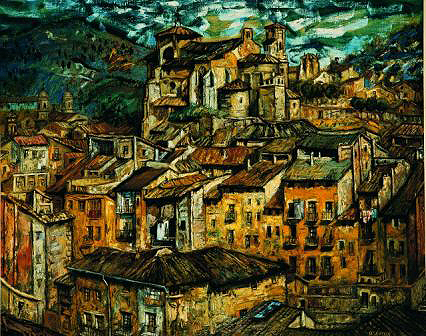
View of Estella, José María Ascunce, 1959-60
Oil on canvas, 135 x cm
Museum of Navarra
conference room 4.3
